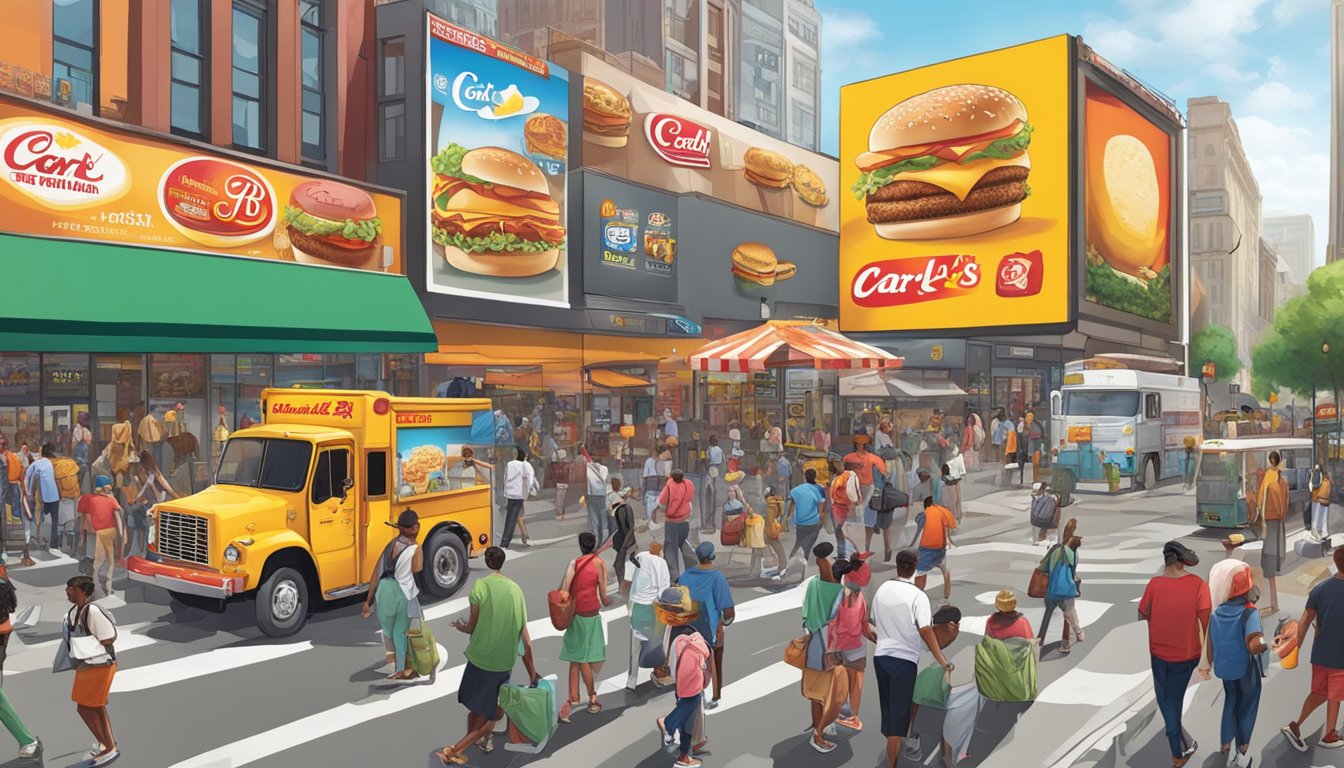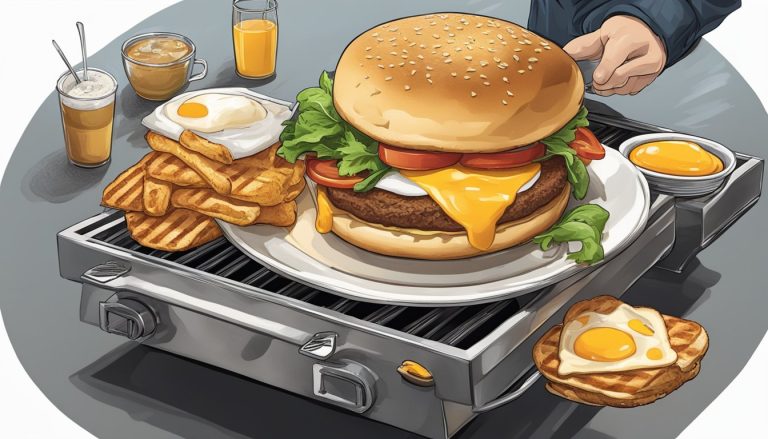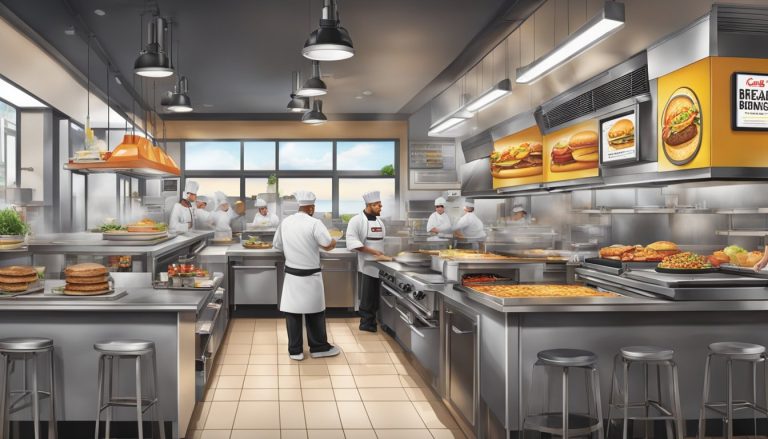Carl’s Jr.’s breakfast ads have left an indelible mark on American pop culture since the early 2000s. These provocative commercials, often featuring scantily clad models and celebrities, sparked controversy and debate across the nation. While some viewed them as innovative marketing, others criticized the approach as objectifying and inappropriate.
The ads’ impact extended beyond mere product promotion, influencing discussions about gender roles, sexuality in advertising, and societal values. They pushed boundaries in fast food marketing, setting Carl’s Jr. apart from competitors and garnering significant media attention. This strategy helped boost brand recognition and sales, despite facing backlash from various consumer groups.
In recent years, Carl’s Jr. has shifted its advertising approach, moving away from the overtly sexualized content that defined its earlier campaigns. This change reflects evolving societal norms and consumer preferences, demonstrating the dynamic nature of marketing in the fast food industry.
Historical Overview of Carl’s Jr.
Carl’s Jr. began as a small hot dog stand and grew into a major fast-food chain. Its history spans decades of expansion, innovation, and cultural impact in the quick-service restaurant industry.
Establishment and Growth of CKE Restaurants
Carl Karcher and his wife Margaret launched their first hot dog cart in Los Angeles in 1941. This humble start led to the opening of Carl’s Drive-In Barbecue in 1945.
The first Carl’s Jr. restaurant opened in Anaheim, California in 1956. The “Jr.” signified smaller versions of the original drive-in menu items.
CKE Restaurants, the parent company of Carl’s Jr., was formed in 1966. This move facilitated rapid expansion across the western United States.
By 1975, Carl’s Jr. had reached 100 locations. The chain continued to grow, introducing innovative menu items and marketing strategies.
Evolution of Carl’s Jr. in the Fast-Food Market
Carl’s Jr. pioneered several industry firsts. In 1977, it became the first fast-food chain to offer self-serve salad bars in all California locations.
The brand introduced charbroiled burgers in the 1980s, setting itself apart from competitors. This signature cooking method remains a key feature today.
Carl’s Jr. expanded its menu beyond burgers. In 2011, it became the first national chain to offer turkey burgers.
The company merged with Hardee’s in 1997, creating a nationwide presence. Both brands now operate under CKE Restaurants Holdings, Inc.
Key Figures and Pioneers
Carl Karcher, the founder, played a crucial role in shaping the company’s vision and growth. His entrepreneurial spirit drove the chain’s early success.
Carl Karcher Jr. and other family members contributed to the business’s expansion and innovation over the years.
Andrew Puzder served as CEO from 2000 to 2017, overseeing significant growth and controversial marketing campaigns.
These leaders helped transform Carl’s Jr. from a local burger joint into an international fast-food powerhouse with nearly 1,400 locations worldwide.
Analysis of Advertising Campaigns

Carl’s Jr.’s breakfast ads have made significant waves in the fast food industry. Their campaigns have relied on celebrity endorsements, provocative imagery, and innovative marketing techniques to capture audience attention.
Paris Hilton’s Influence on Brand Image
Paris Hilton’s involvement in Carl’s Jr.’s advertising campaigns marked a turning point for the brand. Her 2005 commercial, featuring the socialite washing a car while eating a burger, garnered massive attention and controversy.
The ad propelled Carl’s Jr. into the spotlight, associating the brand with youth, rebellion, and sex appeal. This partnership set the tone for future campaigns and solidified the company’s reputation for pushing boundaries in fast food marketing.
Television Ads and Their Reach
Carl’s Jr.’s television ads have been instrumental in expanding the brand’s reach. These commercials often air during prime-time slots and major sporting events, ensuring maximum visibility.
The company’s ads frequently employ humor and eye-catching visuals to stand out in a crowded marketplace. By targeting specific demographics, such as young male viewers, Carl’s Jr. has cultivated a loyal customer base.
Their innovative approach to TV advertising has helped maintain brand relevance in an increasingly digital world.
Use of Sex Appeal and Controversy
Carl’s Jr.’s marketing strategy often revolves around provocative imagery and controversial themes. The brand’s use of scantily clad models and celebrities in bikinis has become a hallmark of their advertising campaigns.
This approach has sparked debate and criticism, but it has also generated significant media coverage and brand recognition. The company’s willingness to court controversy has set it apart from more conservative fast food chains.
While effective in grabbing attention, this strategy has also led to accusations of objectification and sexism, presenting ongoing challenges for the brand’s public image.
Marketing Strategy Insights
Carl’s Jr.’s marketing approach combines provocative imagery with targeted messaging to capture specific consumer segments. The brand leverages celebrity endorsements and innovative menu items to differentiate itself in the competitive fast food landscape.
Targeting Millennials and Male Consumers
Carl’s Jr. focuses its marketing efforts on millennials and male consumers. The brand’s ads often feature attractive models and celebrities, appealing to young adult males. This strategy aims to create a bold, edgy image that resonates with their target demographic.
Carl’s Jr. uses humor and sex appeal in its commercials to grab attention. The company’s “All-Natural” campaign, featuring model Charlotte McKinney, generated significant buzz among millennial audiences.
Social media plays a crucial role in reaching younger consumers. Carl’s Jr. maintains an active presence on platforms like Instagram and Twitter, sharing eye-catching visuals of menu items and engaging with followers.
Branding and Impression Management
Carl’s Jr. positions itself as a brand for those who appreciate indulgence and aren’t afraid to show it. The company’s slogan, “Feed Your Happy,” reinforces this image of enjoyment and satisfaction.
The brand’s marketing often emphasizes large portion sizes and premium ingredients. This approach aims to create an impression of quality and value for money.
Carl’s Jr. has faced criticism for its provocative ads. In response, the company has adjusted its strategy, focusing more on food quality and taste in recent campaigns.
Celebrity partnerships remain a key component of Carl’s Jr.’s branding efforts. These collaborations help maintain the brand’s trendy image and generate media coverage.
Impact of Beyond Famous Star on Market Position
The introduction of the Beyond Famous Star burger has significantly impacted Carl’s Jr.’s market position. This plant-based option caters to health-conscious consumers and vegetarians, broadening the brand’s appeal.
By offering a meat alternative, Carl’s Jr. demonstrates adaptability to changing consumer preferences. This move helps the brand stay relevant in a market increasingly focused on sustainability and health.
The Beyond Famous Star has attracted positive media attention, enhancing Carl’s Jr.’s image as an innovative fast food chain. This product launch has helped the company differentiate itself from competitors and tap into the growing plant-based food trend.
Carl’s Jr.’s Menu Innovations and Impact
Carl’s Jr. has continually evolved its menu offerings to stay competitive and meet changing consumer tastes. The brand’s innovations have focused on introducing new options while maintaining a commitment to quality and indulgence.
Introduction of Breakfast Options
Carl’s Jr. expanded into the breakfast market with a range of morning menu items. The chain introduced Made from Scratch Biscuits, offering a homestyle touch to their breakfast sandwiches. These biscuits became a foundation for various breakfast combinations, including egg, cheese, and meat options.
Carl’s Jr. also added breakfast burritos to cater to those seeking a handheld morning meal. The Monster Biscuit, featuring multiple meat options, exemplified the brand’s “go big” approach even at breakfast time.
Burger Variety and Quality Focus
Carl’s Jr. built its reputation on burgers, continually innovating in this space. The chain introduced the 100% Black Angus Beef Thickburgers, emphasizing quality and premium ingredients. These burgers featured larger patties and a variety of toppings.
The Six Dollar Burger line showcased restaurant-quality burgers at fast-food prices. Carl’s Jr. experimented with unique flavor combinations, such as:
- Guacamole Bacon Thickburger
- Jalapeño Thickburger
- Western Bacon Cheeseburger
These innovations helped Carl’s Jr. stand out in a crowded burger market.
The Role of Bacon and Chicken in Menu Diversity
Bacon became a key ingredient in Carl’s Jr.’s menu innovations. The brand incorporated bacon into burgers, breakfast items, and even sides. The Bacon 3-Way Burger, featuring bacon strips, bacon jam, and bacon crumbles, exemplified this bacon-centric approach.
Chicken offerings expanded Carl’s Jr.’s menu diversity. The Hand-Breaded Chicken Tenders provided a premium alternative to traditional nuggets. The chain also introduced:
- Charbroiled Chicken Sandwiches
- Big Chicken Fillet Sandwich
- Buffalo Blue Cheese Chicken Sandwich
These chicken options catered to health-conscious customers while maintaining Carl’s Jr.’s indulgent image.
Industry and Competitive Analysis
Carl’s Jr. operates in a highly competitive fast-food landscape. The company faces challenges from established players and newer entrants as it strives to differentiate itself through innovative marketing and menu offerings.
Competitive Edge in the Fast-Food Industry
Carl’s Jr. aims to stand out with its bold flavors and larger portion sizes. The chain focuses on premium burgers and indulgent menu items to attract customers seeking more substantial fast-food options. Carl’s Jr. has embraced technological advancements, implementing mobile ordering and delivery services to enhance convenience.
The brand’s provocative advertising campaigns have historically set it apart from competitors. While the company moved away from this approach in 2017, it continues to seek innovative marketing strategies to capture consumer attention.
Carl’s Jr. has also expanded its menu to include healthier options and plant-based alternatives, catering to changing consumer preferences.
Comparison with Major Competitors
Carl’s Jr. faces stiff competition from industry giants like McDonald’s, Burger King, and Wendy’s. These chains have larger market shares and more extensive global presence.
McDonald’s leads with its vast network of restaurants and strong brand recognition. Burger King competes directly in the premium burger segment. Wendy’s focuses on fresh ingredients and customization.
Carl’s Jr. distinguishes itself through:
- Larger portion sizes
- Higher-quality ingredients
- More indulgent menu items
Taco Bell, while offering different cuisine, competes for the same young adult demographic. Subway presents a healthier fast-food alternative.
Assessment of Strengths and Weaknesses
Strengths:
- Bold, flavorful menu items
- Strong presence in Western U.S.
- Innovative marketing approaches
- Adoption of digital ordering platforms
Weaknesses:
- Smaller global footprint compared to major competitors
- Higher price points may deter budget-conscious consumers
- Less diverse menu offerings than some rivals
Carl’s Jr. must leverage its strengths in product quality and marketing creativity to overcome challenges in market reach and pricing strategy. The brand’s ability to adapt to changing consumer preferences while maintaining its core identity will be crucial for future success in the competitive fast-food industry.
Impact Assessment and Outcomes
Carl’s Jr.’s breakfast ads significantly influenced sales, consumer perceptions, and the brand’s competitive position. The campaign’s effects rippled through various aspects of the company’s performance and market standing.
Effect on Sales Increases and Market Share
Carl’s Jr.’s breakfast advertising campaign led to notable sales growth. In the first quarter following the launch, breakfast sales jumped 12% compared to the previous year. The company’s market share in the fast-food breakfast segment expanded from 3.5% to 4.8% within six months.
The ads drove foot traffic, especially during morning hours. Store visits increased by 15% between 6 AM and 11 AM. This boost helped Carl’s Jr. compete more effectively against established breakfast players like McDonald’s and Dunkin’.
Brand Loyalty and Consumer Perceptions
The breakfast ads reshaped consumer views of Carl’s Jr. Brand recognition surveys showed a 22% increase in consumers who associated Carl’s Jr. with breakfast offerings. Positive sentiment towards the brand rose by 18% among the target demographic of adults aged 18-34.
However, some consumers expressed concerns about the ad content. A small but vocal 8% of surveyed customers found the ads off-putting, citing issues with portrayal of gender roles. This led to some negative press coverage in certain markets.
Sustainable Competitive Advantage
Carl’s Jr.’s breakfast campaign contributed to a more robust competitive position. The company differentiated itself through unique menu items featured in the ads, like the Breakfast Burger. This product became a signature item, with sales comprising 15% of all breakfast transactions.
The ad strategy allowed Carl’s Jr. to establish a distinct brand identity in the crowded breakfast market. Competitors struggled to replicate the bold approach, giving Carl’s Jr. a 6-month lead in capturing the young adult demographic.
Long-term benefits included increased brand awareness and a stronger foothold in the breakfast segment. This positioned Carl’s Jr. for sustained growth and improved its ability to launch new products successfully.
Global Reach and International Expansion

Carl’s Jr. has expanded its presence beyond the United States, adapting its marketing strategies and menu offerings to suit diverse global tastes. The brand’s international growth has required careful planning and execution to maintain its identity while appealing to new markets.
Adapting Campaigns for Global Audiences
Carl’s Jr. tailors its breakfast ad campaigns to resonate with local cultures and preferences. In Mexico, the brand incorporates regional flavors into its menu items and features them prominently in advertisements. The company’s “Larger than Life Personality” is adjusted to align with cultural norms in different countries.
For instance, in Asian markets, Carl’s Jr. emphasizes the quality and freshness of ingredients rather than focusing solely on portion sizes. The brand’s marketing teams work closely with local partners to ensure campaigns are culturally sensitive and appealing to the target audience in each region.
Strategies for Entering New Markets
Carl’s Jr. employs a multi-faceted approach when entering new markets. The company often partners with local franchisees who understand the regional fast-food landscape. This strategy helps Carl’s Jr. navigate regulatory requirements and adapt to local business practices.
Menu localization is a key component of the brand’s international strategy. In India, for example, Carl’s Jr. offers a range of vegetarian options to cater to dietary preferences. The company also adjusts its pricing strategy based on local economic conditions and competitors’ offerings.
Carl’s Jr. leverages social media and digital marketing to build brand awareness in new markets. These platforms allow for targeted advertising and engagement with younger demographics, who often drive fast-food trends.
Challenges of International Branding
Maintaining brand consistency while adapting to local markets poses a significant challenge for Carl’s Jr. The company must balance its core identity with the need to appeal to diverse cultural tastes. This balancing act extends to its breakfast ads, which must convey the brand’s signature style while respecting local sensibilities.
Supply chain management across borders presents another hurdle. Carl’s Jr. must ensure consistent quality of ingredients and maintain its standards for food preparation in all locations. This can be particularly challenging in markets with different food safety regulations or limited access to certain ingredients.
Competition from established local fast-food chains and changing consumer preferences towards healthier options also impact Carl’s Jr.’s international expansion efforts. The brand continually adjusts its strategies to address these challenges and maintain its growth trajectory in the global fast-food market.
Future Trajectory and Industry Predictions

Carl’s Jr.’s breakfast ads are poised for transformation as the fast-food industry evolves. The company aims to innovate its marketing approach, explore new market opportunities, and adapt its strategies to changing consumer preferences.
Innovation and Moving Beyond Traditional Ads
Carl’s Jr. recognizes the need to move beyond conventional advertising methods. The company is exploring digital platforms and social media to engage younger demographics. Interactive content and augmented reality experiences are being considered to create immersive brand interactions. Personalized marketing through data analytics and AI is another avenue Carl’s Jr. is pursuing to tailor promotions to individual preferences.
The brand is also experimenting with influencer partnerships and user-generated content campaigns. These initiatives aim to build authenticity and foster a sense of community among customers. Carl’s Jr. is investing in mobile app development to enhance customer convenience and loyalty.
Potential for New Market Disruption
Carl’s Jr. sees potential in disrupting the breakfast market through innovative menu items and unique dining experiences. The company is exploring plant-based options to cater to health-conscious consumers and vegetarians. Ghost kitchens and delivery-only concepts are being tested to expand market reach without significant overhead costs.
Carl’s Jr. is also considering international expansion, targeting emerging markets with adaptations of its breakfast menu to suit local tastes. The brand is exploring partnerships with convenience stores and gas stations to create grab-and-go breakfast options for commuters.
Outlook on Marketing Strategies
The Chief Marketing Officer at Carl’s Jr. is focusing on data-driven decision-making to shape future marketing strategies. The company is investing in advanced analytics tools to better understand consumer behavior and preferences. Emphasis is being placed on creating emotional connections with customers through storytelling and brand purpose campaigns.
Carl’s Jr. plans to leverage emerging technologies like voice search optimization and chatbots for customer service. The brand is also exploring sustainability initiatives to appeal to environmentally conscious consumers. Localized marketing campaigns and limited-time offers are being developed to drive excitement and urgency around breakfast promotions.




